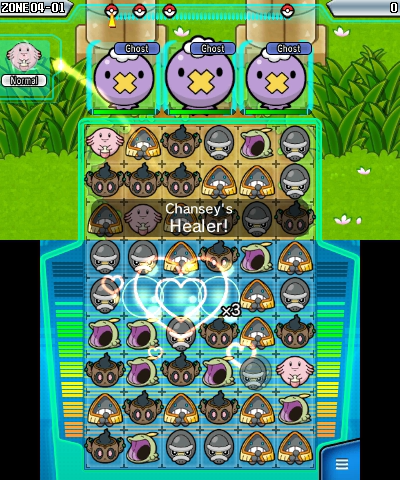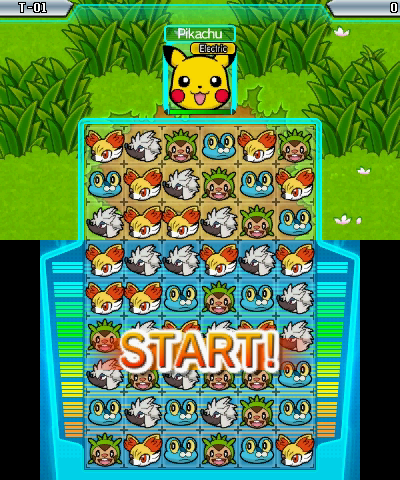Pokémon Link: Battle! Review
There have been many Pokémon spinoffs over the years, but none deviate from the regular franchise more than Pokémon Link, a match three-puzzle game. The first game was entirely forgettable, but the series is back with a brand new battle mechanic that changes a great deal.
The core of the game itself hasn’t changed all that much, however, and you are still tasked with lining up three or more Pokémon on the 3DS’ bottom screen in order to make them disappear from the “Link Box” (the name given to the bottom screen). Matching up these Pokémon will add points to your score.
 Pokémon can be dragged from anywhere in the Link Box and swapped with another Pokémon. Providing there are at least three of the same Pokémon on the screen a link can be made, but finding these links in a timely manner is the challenge. The gameplay is quite addictive to start with, and results in a great feeling of satisfaction, but after a while it becomes stale. The Pokémon you link may change but the interaction doesn’t, resulting in a lot of repetition.
Pokémon can be dragged from anywhere in the Link Box and swapped with another Pokémon. Providing there are at least three of the same Pokémon on the screen a link can be made, but finding these links in a timely manner is the challenge. The gameplay is quite addictive to start with, and results in a great feeling of satisfaction, but after a while it becomes stale. The Pokémon you link may change but the interaction doesn’t, resulting in a lot of repetition.
Link Battle! differs from the original mainly because of the Pokémon battles that occur on the top screen. When you manage to link up three or more Pokémon the linked ones will start an attack on the wild ones you are currently battling. If you manage to link more Pokémon in quick succession, the damage multiplier on the attack will increase.
Each area sees you fighting multiple Pokémon in a row, sometimes facing multiple enemies at the same time. Fortunately, linking 5 or more Pokémon will result in a scatter attack that will hit every enemy on the screen. This is where the strategy element starts to creep in: when fighting multiple enemies it is key to use scatter attacks in order to dispose of the wild Pokémon as quickly as possible; going one by one will not only take up time but will make you take a lot more damage.
 Another strategic element is using a Pokémon’s weakness against it. As any seasoned trainer will know, water type Pokémon are especially effective against fire types, and fire types are especially effective against grass. By making sure to link a Pokémon who is strong against an enemy first you can guarantee your attack will be super effective and will deal a lot of damage. Often linking a Pokémon you know is weak against the enemy is a bad move, as in the time you take to do minimal damage the enemy will hit you hard.
Another strategic element is using a Pokémon’s weakness against it. As any seasoned trainer will know, water type Pokémon are especially effective against fire types, and fire types are especially effective against grass. By making sure to link a Pokémon who is strong against an enemy first you can guarantee your attack will be super effective and will deal a lot of damage. Often linking a Pokémon you know is weak against the enemy is a bad move, as in the time you take to do minimal damage the enemy will hit you hard.
Fortunately you can chose support Pokémon to accompany you on each stage. These Pokémon can be chosen from those that you have previously defeated in battle and will pop up with the other, area specific, Pokémon in the Link Box. Choosing the right support Pokémon is important – for example, taking a Charmander to fight a Squirtle is never going to work, but taking a Bulbasaur will give you a massive tactical advantage. The addition of support Pokémon certainly makes the game more interesting, as finding the right combination of supports to take into each zone provides a welcome challenge, one that Pokémon Masters will easily solve. For those new to the series, it’s a great way to educate them about the advantages and disadvantages of each Pokémon.
Sadly, even the best support Pokémon wont prepare you for the major difficulty spike around zone 7. Up until then, most battles aren’t particularly challenging and can be beaten providing you don’t mess up. The first level in zone 7 ramps up the difficulty and had me stumped and frustrated for quite some time – it was only after I equipped the perfect support Pokémon and got a bit of luck in the final battle that I beat it, hoping that it was a one off. But it wasn’t. Each level past the first in zone 7 is insanely difficult and feels unfair, which is the total opposite of all the previous levels that could do with a bit more challenge.
 The overall meta game revolves around trying to defeat or link all 718 Pokémon, a challenge that will take some time. The safari zone will need to farmed daily to be able to complete this challenge, as new Pokémon are available every day. You will also have to have cleared every zone of every Pokémon, many of which have a random chance of appearing in each battle.
The overall meta game revolves around trying to defeat or link all 718 Pokémon, a challenge that will take some time. The safari zone will need to farmed daily to be able to complete this challenge, as new Pokémon are available every day. You will also have to have cleared every zone of every Pokémon, many of which have a random chance of appearing in each battle.
Visually, the Pokémon are quite cute and are instantly recognizable to anyone who has played a game in the series, although some do look very similar when you are rushing to link them together. Attacks have very basic animations, and unfortunately none really take advantage of the 3D effect on the top screen.
VERDICT: This is a fun game to play in the early stages but the difficulty spike around area 7 makes the game frustrating form thereon in. The gameplay is frantic but has key strategies that need to be applied and the support Pokémon add to that. The meta game of collecting all the Pokémon will surely keep many people playing for hours, but the difficulty spike will turn even more away.
Pokémon Link Battle! has a surprising amount of charm with the cute character sprites and animations, but while the gameplay is somewhat addictive to start with, it quickly becomes repetitive. Taken in tandem with the other issues, it makes Pokémon Link Battle difficult to recommend.

AVERAGE. The epitome of a 50/50 game, this title will be unspectacular but inoffensive, charmless but amiable. We aren’t condemning a game by scoring it a 5, but we certainly aren’t championing it, either.
Review code provided by publisher.




